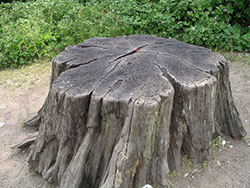There are several ways to remove a tree stump. Before choosing a removal method, check local ordinances about retaining dead trees or burning stumps in your yard.
- Dig up the stump with a sharp spade or pick. This is both time- and labor-intensive, but effective. This method works well depending on the size of the stump and the enthusiasm of the labor crew.
- Consult a local arborist or tree service. Tree specialists use professional equipment to grind or chip the stump into large shreds before removing it. The cost for
 this service varies depending on the size and placement of the stump.
this service varies depending on the size and placement of the stump. - Speed up the decomposition process of the stump with chemicals available at garden centers, nurseries or hardware stores. Instructions for stump removal chemicals will vary from product to product, but all require drilling several holes in the stump. A measured amount of chemical is poured in each hole, then water is added to fill the holes. Let the mixture stand for four to six weeks. Repeat applications may be necessary. Once the stump is decomposed, it is burned.
- Include the stump in your landscaping. Hollow out the top with a router or drill and use it as a bird feeder. Fill it with water and watch the birds and butterflies it attracts, especially if surrounded by other trees and shrubs that offer a safe haven. Climbing vines or annuals planted in the stump with good garden soil can turn the stump into a natural container.
- Finally, let the stump decay naturally. Cut off all new sucker growth before it reaches eight inches in height to gradually deplete the stored food. This can take five to 10 years, but is easy, inexpensive and chemical-free. As the wood softens it becomes more pliable. If a tree trunk is left, it can provide shelter for birds and small mammals.



